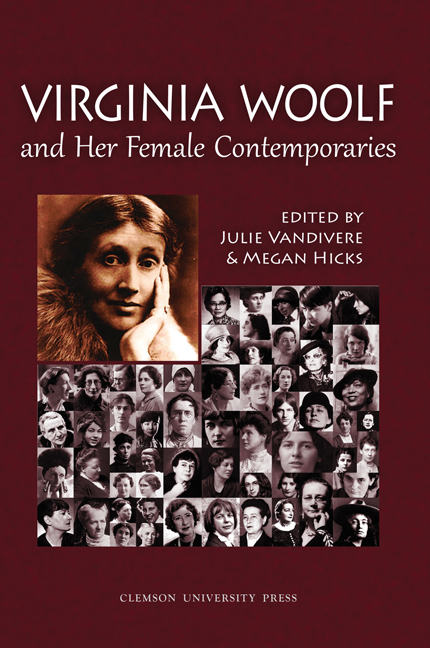Book contents
- Frontmatter
- Table of Contents
- Introduction
- Acknowledgments
- Abbreviations
- Who Are Virginia Woolf's Female Contemporaries?
- Virginia Woolf's Cultural Contexts
- Virginia Woolf's Contemporaries Abroad
- Virginia Woolf's Contemporaries at Home
- “The Squeak of a Hinge”: Hinging and Swinging in Woolf and Mansfield
- “People must marry”: Queer Temporality in Virginia Woolf and Katherine Mansfield
- The Weight of “Formal Obstructions” and Punctuation in Mrs. Dalloway and Pointed Roofs
- Advise and Reject: Virginia Woolf, the Hogarth Press, and a Forgotten Woman's Voice
- Florence Melian Stawell and Virginia Woolf: Home-front Experience, The Price of Freedom, and Patriotism
- Intimations of Cosmic Indifference in Virginia Woolf 's Orlando and Olive Moore's Spleen
- “Could I sue a dead person?”: Rebecca West and Virginia Woolf
- Splintered Sexualities in Rebecca West's The Return of the Soldier, Virginia Woolf 's Mrs Dalloway, and Sylvia Townsend Warner's “A Love Match”
- Sexual Cryptographies and War in Virginia Woolf 's Between the Acts and Elizabeth Bowen's The Heat of the Day
- Tribute to Jane Marcus
- Notes on Contributors
- Conference Program 223
Florence Melian Stawell and Virginia Woolf: Home-front Experience, The Price of Freedom, and Patriotism
from Virginia Woolf's Contemporaries at Home
- Frontmatter
- Table of Contents
- Introduction
- Acknowledgments
- Abbreviations
- Who Are Virginia Woolf's Female Contemporaries?
- Virginia Woolf's Cultural Contexts
- Virginia Woolf's Contemporaries Abroad
- Virginia Woolf's Contemporaries at Home
- “The Squeak of a Hinge”: Hinging and Swinging in Woolf and Mansfield
- “People must marry”: Queer Temporality in Virginia Woolf and Katherine Mansfield
- The Weight of “Formal Obstructions” and Punctuation in Mrs. Dalloway and Pointed Roofs
- Advise and Reject: Virginia Woolf, the Hogarth Press, and a Forgotten Woman's Voice
- Florence Melian Stawell and Virginia Woolf: Home-front Experience, The Price of Freedom, and Patriotism
- Intimations of Cosmic Indifference in Virginia Woolf 's Orlando and Olive Moore's Spleen
- “Could I sue a dead person?”: Rebecca West and Virginia Woolf
- Splintered Sexualities in Rebecca West's The Return of the Soldier, Virginia Woolf 's Mrs Dalloway, and Sylvia Townsend Warner's “A Love Match”
- Sexual Cryptographies and War in Virginia Woolf 's Between the Acts and Elizabeth Bowen's The Heat of the Day
- Tribute to Jane Marcus
- Notes on Contributors
- Conference Program 223
Summary
My interest in Florence Melian Stawell—and hence this paper—begins with Roger Fry (1866–1934) and the Great War—or, more particularly, his artwork, the enormous (182.9 x 152.4 cm./72 x 60 in.) oil and papier collé composition, German General Staff (or Three Men in Military Coats), a photograph of which is used as the cover of my book Virginia Woolf and the Great War (1999). This in turn points to the part serendipity plays in our lives as readers and writers, academics, students, and scholars, and how I came to have an interest in Melian Stawell (1869–1936), as she was called by her contemporaries and fellow civilians—including Roger Fry, Vanessa Bell, Virginia Woolf, Mary Sheepshanks, Bertrand Russell, G. Lowes Dickinson, Gilbert Murray, and Ottoline Morrell, among many other friends, family, colleagues, associates, and students. Although Fry's actual picture has been lost, up to a point we can trace its provenance, beginning on November 16, 1915, when it was among 54 works of Fry included in his one-man show at the Alpine Club Gallery, most of which had been completed during the first year of the war. Given its “subversive” intent, Fry was surprised at the positive response the picture elicited owing to what was perceived as its “patriotic sentiment” (Cork 80; Spalding 199). Listed in the exhibition catalogue as Three Men in Long Military Cloaks, Fry's inspiration was a newspaper photograph of German military officers, which, his daughter said, suggested men without feet on the ground, men without a sense of reality (Spalding 199; Cork 80 and 317n62). Undoubtedly owing to the unexpectedly favorable reviews and as evidenced by the stamp on the back of the picture, Roger Fry submitted it to the Ministry of Information in an ultimately unsuccessful effort to become an official artist of the war. He still had the picture in 1917, when the photographic representation of it first appeared as an illustration in Melian Stawell's The Price of Freedom: An Anthology for All Nations (1917), with an appendix saying that it was “[s]till in the artist's possession” (160). In 2011, when Stawell's anthology was listed in Catalogue 47 of Jon Richardson (a rare books dealer specializing in Bloomsbury) as including the very Fry picture and Stawell's listing (23), I made contact—just in case—and bought the Stawell.
- Type
- Chapter
- Information
- Virginia Woolf and Her Female Contemporaries , pp. 177 - 182Publisher: Liverpool University PressPrint publication year: 2016

